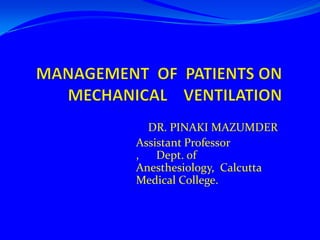
Venti
- 1. MANAGEMENT OFPATIENTS ON MECHANICALVENTILATION DR. PINAKI MAZUMDER Assistant Professor , Dept. of Anesthesiology, Calcutta Medical College.
- 2. INDICATIONS OF MECHANICAL VENTILATION Inadequate tissue oxygenation Inadequate tissue perfusion Inadequate ventilation MECHANISM OF OXYGEN TRANSPORT
- 4. Neurogenic (spinal injury)
- 6. CVA
- 10. Neurotoxic snake bite
- 13. Tracheostomy for long term ventilation
- 14. Size of endotracheal tube
- 15. 8.0 to 8.5 mm for adult males
- 20. Nasal tubes require 5 cm additional length.
- 21. Adhesive tape with counter-traction force for tube fixation
- 22. Head is kept at neutral position
- 25. Assist Control mode ventilation (ACV): delivers fixed volume/ pressure in response to spontaneous breath.
- 29. Plateau pressure < 30 cm H2O
- 30. High volume -> barotrauma/volutrauma
- 32. High rate ( 20 – 25/ min) in ARDS
- 33. Low rate for COPDMinute ventilation : 5 – 10 lt/min Inspiration expiration ratio: 1:2 to 1: 3 Oxygen concentration :start with 100% , decrease to 60 % to achieve SpO2 >90% or PaO2 > 60 mm Hg
- 36. start with 3-5 cm H2O , increase up to 15 cm H2O
- 42. Tidal volume
- 46. Static and Dynamic compliance
- 47. Gas exchange parameters- PaO2. FiO2 periodically recorded.
- 48. Goal of Ventilation Adequate oxygenation and ventilation Prevent oxygen toxicity by using FiO2 < 0.6 Use PEEP in refractory hypoxia Maintain normal blood volume, pump function, cardiovascular parameters. Adequate Hb concentration Humidification of the inspired gas Frequent aseptic tracheo-bronchial suction Good physiotherapy and Organ support.
- 49. Problems during Ventilation Asynchrony between patient and ventilator : Reassure the patient , give sedative analgesic. Increase minute ventilation Give higher FiO2 Increase inspiratory flow rate Manually ventilate with 100% oxygen for 5 minutes- if severe resistance felt, change the tube. Rule out associated problems- acidosis, electrolyte disorders, pain, fever , shock, full bladder or stomach. Neuromuscular blocker - as last resort.
- 51. Disconnection/ leak in circuit
- 52. Leakage in cuff
- 54. High airway pressure alarm
- 55. Kinking /Blockade of ET tube/ tracheostomy tube
- 56. Bronchospasm
- 57. Decreased lung compliance
- 58. Oxygen alarm
- 61. Aseptic suction
- 62. Physiotherapy
- 63. Postural drainage
- 65. Weaning from ventilator Patient clinically stable ,underlying disease improved PaO2 > 70 mmHg , PCO2 < 45 mm Hg on FiO2 0.4 , acid base status, electrolytes, blood biochemistry, and chest x ray are near normal Hemodynamically stable No fever or Organ failure or Bleeding Nutritional status is good Neuromuscular function is adequate. bedside test: if respiratory rate > 30 or tidal volume < 300 ml then continue ventilation
- 66. Modes of weaning Patient connected to ventilator Pressure Support Ventilation (PSV) SIMV with gradual decrease of rate. Patient removed from ventilator Daily T piece trial of 60 mins or initial 15 – 30 mins trial followed by progressive increase in trial duration over the whole day. Extubate if no respiratory distress / clinically stable.
- 67. Thank you.